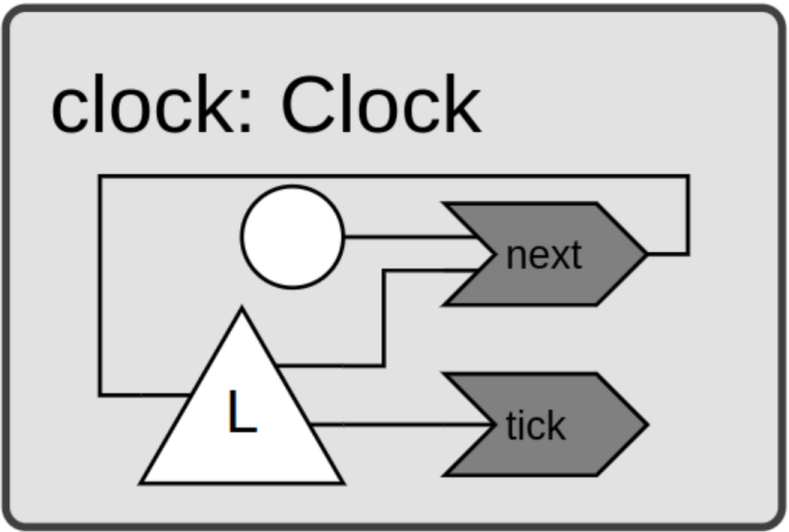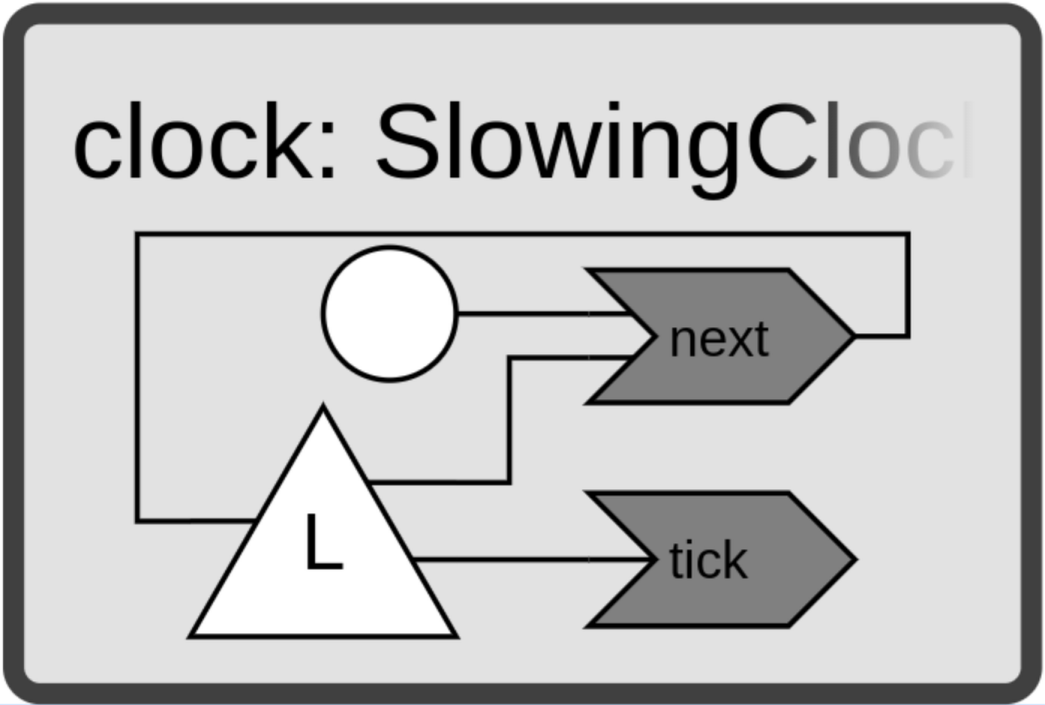Programmable Timers
Programmable timers provide a convenient way for reactors to schedule future behavior. While ports can be used to send messages to other reactors, programmable times can be seen as a mechanism for a reactor to send a delayed messages to its future self.
The following example replicates the behavior of a Periodic Timers using a programmable timer.
import datetime
import xronos
class Clock(xronos.Reactor):
_tick = xronos.ProgrammableTimerDeclaration()
def __init__(self, period: datetime.timedelta):
super().__init__()
self._period = period
def _schedule_next_tick(self, tick_effect):
tick_effect.schedule(value=None, delay=self._period)
@xronos.reaction
def next(self, interface):
interface.add_trigger(self.startup)
interface.add_trigger(self._tick)
tick_effect = interface.add_effect(self._tick)
return lambda: self._schedule_next_tick(tick_effect)
@xronos.reaction
def tick(self, interface):
interface.add_trigger(self._tick)
return lambda: print(f"Tick at {self.get_time_since_startup()}")
def main():
env = xronos.Environment()
env.create_reactor("clock", Clock, period=datetime.timedelta(seconds=1))
env.execute()
if __name__ == "__main__":
main()
import datetime
from typing import Callable
import xronos
class Clock(xronos.Reactor):
_tick = xronos.ProgrammableTimerDeclaration[None]()
def __init__(self, period: datetime.timedelta) -> None:
super().__init__()
self._period = period
def _schedule_next_tick(
self, tick_effect: xronos.ProgrammableTimerEffect[None]
) -> None:
tick_effect.schedule(value=None, delay=self._period)
@xronos.reaction
def next(self, interface: xronos.ReactionInterface) -> Callable[[], None]:
interface.add_trigger(self.startup)
interface.add_trigger(self._tick)
tick_effect = interface.add_effect(self._tick)
return lambda: self._schedule_next_tick(tick_effect)
@xronos.reaction
def on_tick(self, interface: xronos.ReactionInterface) -> Callable[[], None]:
interface.add_trigger(self._tick)
return lambda: print(f"Tick at {self.get_time_since_startup()}")
def main() -> None:
env = xronos.Environment()
env.create_reactor("clock", Clock, period=datetime.timedelta(seconds=1))
env.execute()
if __name__ == "__main__":
main()
The Clock reactor declares a programmable timer called _tick using a
ProgrammableTimerDeclaration. The reactor further defines two
reactions. The on_tick reaction is triggered by _tick and prints a message
that includes the current time. The next reaction is triggered both by
startup and by _tick. It also declares an effect on
_tick. Using the ProgrammableTimerEffect object, the reaction
may call schedule() to schedule a future event. In
this example, the reaction handler calls _schedule_next_tick() which in turn
calls schedule() using self._period as
delay.
The next reaction ensures that _tick triggers in regular intervals. The
first invocation of the next reaction handler is triggered by
startup. In this first invocation, the handler schedules
the first event on _tick. All subsequent invocations of next will be
triggered by _tick itself.
When executed, the program produces the following output.
$ python clock.py
Tick at 0:00:01
Tick at 0:00:02
Tick at 0:00:03
Tick at 0:00:04
Tick at 0:00:05
...
While we can use programmable timers to replicate the behavior of periodic timers, they are a lot more versatile. Since new events are scheduled by reactions, the reaction handlers gain full control over when events occur. This allows us to implement more interesting behavior. For instance, the following example implements a clock that slows down with each tick.
class SlowingClock(Clock):
def __init__(self, period, increment):
super().__init__(period)
self._increment = increment
def _schedule_next_tick(self, tick_effect):
tick_effect.schedule(value=None, delay=self._period)
self._period += self._increment
def main():
env = xronos.Environment()
env.create_reactor(
"clock",
SlowingClock,
period=datetime.timedelta(seconds=1),
increment=datetime.timedelta(milliseconds=200),
)
env.execute()
if __name__ == "__main__":
main()
class SlowingClock(Clock):
def __init__(
self, period: datetime.timedelta, increment: datetime.timedelta
) -> None:
super().__init__(period)
self._increment = increment
def _schedule_next_tick(
self, tick_effect: xronos.ProgrammableTimerEffect[None]
) -> None:
tick_effect.schedule(value=None, delay=self._period)
self._period += self._increment
def main() -> None:
env = xronos.Environment()
env.create_reactor(
"clock",
SlowingClock,
period=datetime.timedelta(seconds=1),
increment=datetime.timedelta(milliseconds=200),
)
env.execute()
if __name__ == "__main__":
main()
With this modification, the program produces the following output.
$ python clock.py
Tick at 0:00:01
Tick at 0:00:02.200000
Tick at 0:00:03.600000
Tick at 0:00:05.200000
Tick at 0:00:07
...

